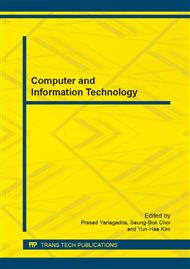p.1243
p.1247
p.1252
p.1258
p.1264
p.1271
p.1276
p.1281
p.1287
A Wireless Sensor Network Node Coverage Discriminant Model Based on the Average Distance of Neighbor Node
Abstract:
Based on the SITE algorithm, this paper proposed a wireless sensor network node coverage discrimination model based on the average distance of neighbor node (ADDM), which can discriminate whether the node is redundant node or not by computing the average distance of the neighbor nodes and the radius angle of overlap area. Theoretical analysis and simulation results showed that the ADDM algorithm better to improve the SITE algorithm, resolve the shortage that the SITE algorithm neglects the effect of the node of distance is greater than the radius of perception, realize the regional coverage with fewer nodes, So as to prolong the network life time.
Info:
Periodical:
Pages:
1264-1270
Citation:
Online since:
February 2014
Authors:
Price:
Сopyright:
© 2014 Trans Tech Publications Ltd. All Rights Reserved
Share:
Citation:


